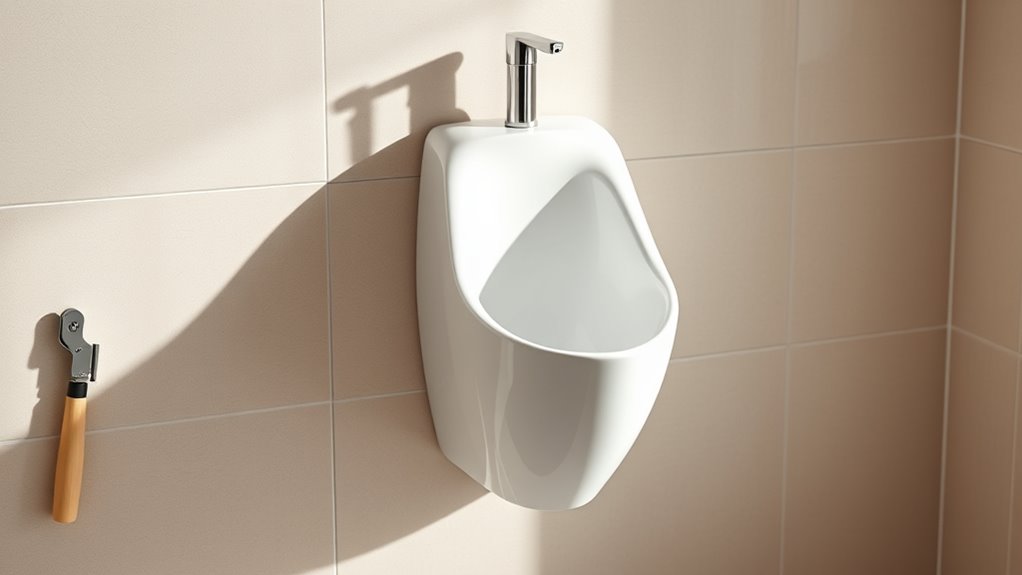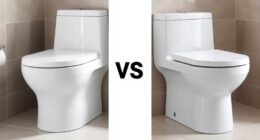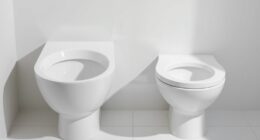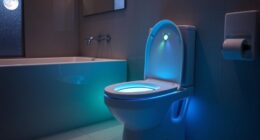Home urinals can save space, reduce water use, and improve hygiene, making them a smart addition to your bathroom. However, they require regular maintenance to prevent odors, clogs, and leaks, especially if you choose waterless or automatic models. Proper installation is key to guarantee efficiency and hygiene, so hiring a professional is often worthwhile. Curious about how to choose and install the right one? Keep exploring to get all the essential tips and insights.
Key Takeaways
- Home urinals save space, reduce water usage, and improve hygiene, but may require regular maintenance and cleaning.
- Choosing between waterless, water-flush, wall-mounted, or floor-mounted models depends on bathroom layout and user needs.
- Proper installation by a professional ensures secure mounting, correct plumbing, and long-term functionality.
- Regular maintenance, including cleaning traps and replacing deodorizer cartridges, prevents odors and extends urinal lifespan.
- Weigh initial costs against ongoing maintenance to determine the most cost-effective and efficient urinal option for your home.
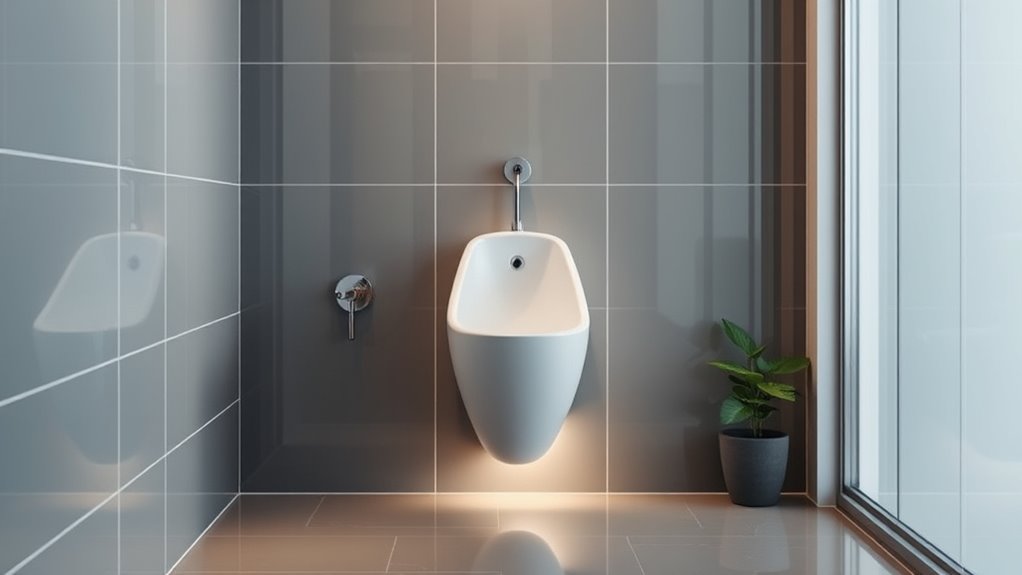
Have you ever considered installing a urinal in your home? It might seem like an unusual choice, but many homeowners are exploring this option for convenience and hygiene. Before you decide, it’s helpful to understand the different urinal types available and what maintenance they require. Urinal types vary based on design, flushing mechanism, and installation style. There are wall-mounted models, which save space and make cleaning easier, and floor-mounted units that might suit larger bathrooms or specific layouts. Some urinals come with automatic flushing systems, offering hands-free operation, while others use manual flush valves. You also have options like waterless urinals, which use special traps to prevent odors without relying on water. Knowing the differences can help you select the right fit for your home, especially if you’re considering long-term maintenance. Maintenance tips are essential to keep your urinal functioning smoothly. Regular cleaning is necessary to prevent stains, buildup, and odors. Use mild, non-abrasive cleaners to avoid damaging the material—most are made of porcelain or stainless steel, which are durable but still require gentle handling. Make sure to flush the urinal after each use, especially if it’s waterless, to prevent clogs and keep everything hygienic. Periodically check the flush mechanism and seals to confirm they’re working properly; replacing worn-out parts promptly will save you from bigger repairs down the line. If you notice persistent odors, clean the trap and replace the deodorizing cartridges if your model uses them. For waterless models, it’s especially important to keep the trap clean and odor-free, as these rely on a special liquid or sealant to prevent smells from escaping. Proper maintenance also involves inspecting for leaks or cracks, which can cause water wastage or sanitation issues. Keeping the area around your urinal dry and free of debris will help maintain a hygienic environment. When it comes to installation, follow the manufacturer’s instructions carefully. Proper placement, secure mounting, and correct connection to the plumbing system are essential for efficient operation. If you’re unsure about the process, hiring a professional plumber can save you time and prevent costly mistakes. Additionally, understanding the importance of software quality assurance can help you ensure that your installation process and maintenance procedures adhere to industry standards and best practices. Remember, the decision to install a home urinal involves balancing the convenience against the initial setup cost and ongoing maintenance. With the right type and regular upkeep, a urinal can be an efficient and hygienic addition to your bathroom. Whether you’re upgrading an existing fixture or installing one for the first time, understanding the different urinal types and following proper maintenance tips will help you enjoy its benefits for years to come.
Frequently Asked Questions
Are Home Urinals Suitable for Small Bathrooms?
If you’re wondering whether home urinals suit small bathrooms, they can work well if space constraints are tight. Compact designs help maximize limited space, and they often fit in smaller areas. However, consider aesthetic considerations, as some might find them less visually appealing. Ultimately, if you prioritize saving space and prefer a functional upgrade, a home urinal could be a good choice for your small bathroom.
What Is the Typical Lifespan of a Home Urinal?
The typical lifespan of a home urinal usually ranges from 10 to 20 years, depending on installation costs and material durability. If you choose high-quality materials like vitreous china or stainless steel, your urinal will likely last longer. Proper maintenance and timely repairs also extend its life. Keep in mind that cheaper options may need replacement sooner, so investing in durable materials can save you money in the long run.
Do Home Urinals Require Special Plumbing Upgrades?
You might need plumbing upgrades or modifications for installation, depending on your current setup. Home urinals typically require specific installation requirements, like a proper drain connection and venting. If your existing plumbing isn’t compatible, you’ll have to make upgrades to guarantee proper function and prevent leaks. It’s best to consult a professional to assess your plumbing system and handle any necessary upgrades for a smooth installation.
How Much Maintenance Do Home Urinals Need?
You’ll find that home urinals need minimal maintenance, with cleaning requirements typically needing to be done once a week. The maintenance frequency isn’t high, but regular cleaning helps prevent odors and buildup. Just use a mild cleaner and a brush to keep it fresh. This simple routine guarantees your urinal stays hygienic and odor-free, making it a convenient addition to your bathroom with little ongoing effort.
Are There Eco-Friendly or Water-Saving Home Urinal Options?
Isn’t it time to turn your bathroom into an eco-conscious space? You can find eco-friendly options and water-saving solutions in home urinals that reduce water use without sacrificing function. These innovative designs often feature dual-flush systems or low-flow technology, helping you save water and lower your utility bills. Embracing these options not only benefits the environment but also makes your home more sustainable and efficient.
Conclusion
Considering a home urinal? It’s a decision that can transform your space and save water, but weigh the pros and cons carefully. Imagine the convenience and efficiency you’ll gain, like a silent guardian of your bathroom’s future. With proper installation, you can enjoy these benefits for years to come. Don’t let hesitation hold you back—embrace the change and step into a smarter, more sustainable lifestyle. Your bathroom’s new chapter awaits—are you ready to take the leap?
